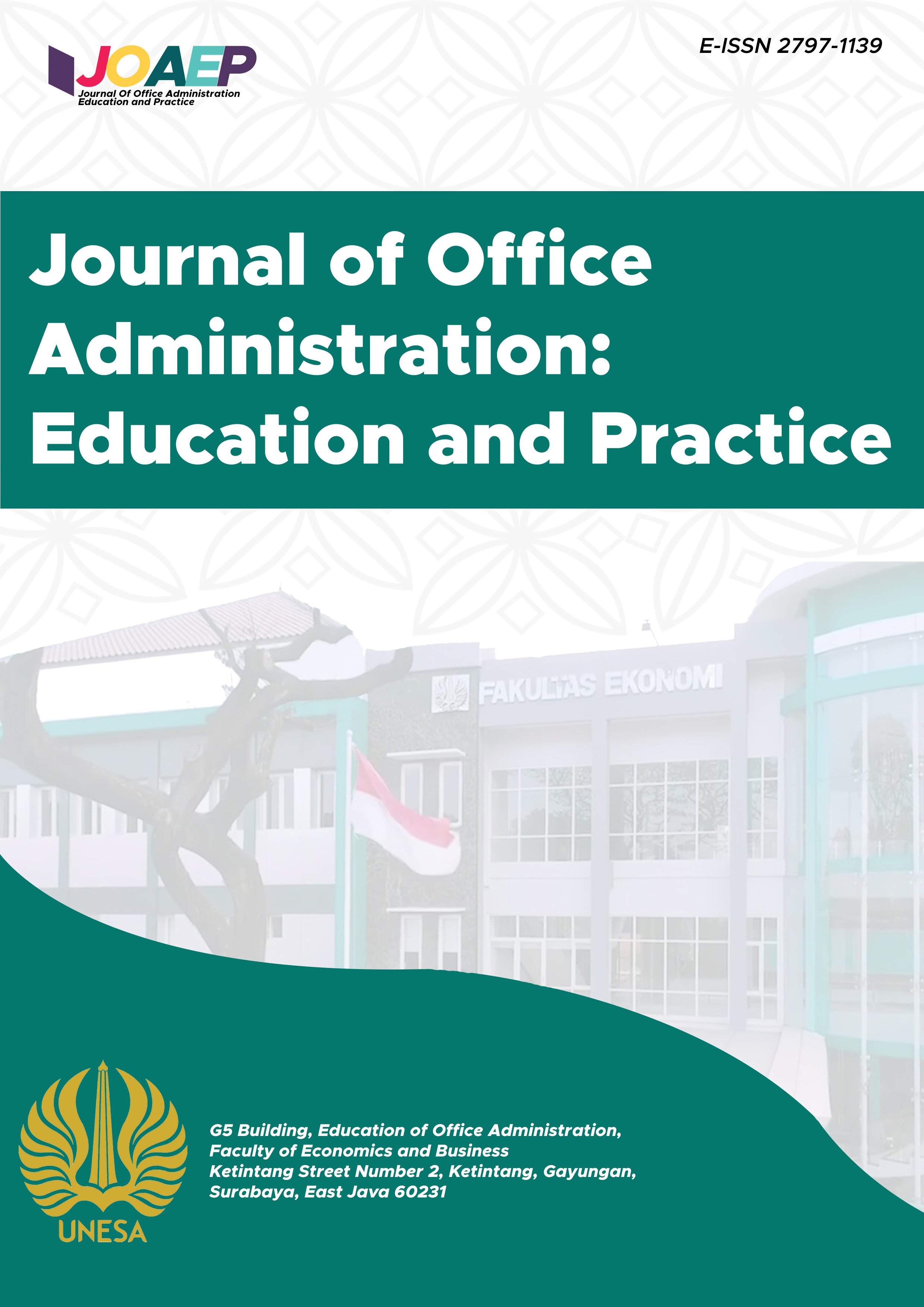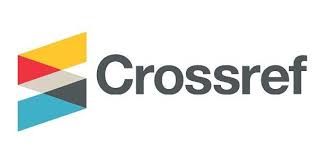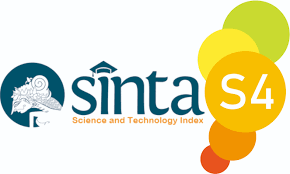Exploring The Impact of Dynamic Learning Capabilities on Career Skill of Generation Z
DOI:
https://doi.org/10.26740/joaep.v4n3.p203-216Keywords:
absorptive capability, innovative capability, self-learning capability, career skill, generation zAbstract
The objective of this study is to examine the influence of absorptive capability, innovative capability, and self-learning capability on the development of career skills of generation Z office/business administration graduates and prospective graduates in Indonesia. The study used a quantitative approach and a cross-sectional survey method to collect data from 100 respondents in Central Java. The respondents were graduates and prospective graduates of office/business administration. The analysis was conducted using the Partial Least Squares Structural Equation Modeling (PLS-SEM) method to test the relationship between latent variables. The findings of the study suggest that the three primary variables (i.e., absorptive capability, innovative capability, and self-learning capability) exert a positive and significant influence on the development of career skills. Furthermore, it was determined that innovative capability and self-learning capability significantly mediate the relationship between absorptive capability and career skills. This study offers a theoretical contribution by expanding the application of dynamic capabilities theory to the realm of individual development. The practical implications of this study are twofold: first, it can serve as a foundational basis for the development of competency development strategies in graduate education and industry; and second, it can equip Generation Z with the relevant skills necessary for the future of work.
Downloads
References
Abbasi, F. K., Ali, A., & Bibi, N. (2018). Analysis of skill gap for business graduates: managerial perspective from banking industry. Education and Training, 60(4), 354–367. https://doi.org/10.1108/ET-08-2017-0120
Agung Nugroho, Y., Putra, F., Novitasari, D., Asbari, M., Purwanto, A., & Tinggi Ilmu Ekonomi Insan Pembangunan, S. (2021). Developing Innovation Capability: Between Individual and Organizational Factors. International Journal of Social and Management Studies (IJOSMAS), 1(1), 74–89. http://www.ijosmas.org
Al-Shami, S. A., Rafeea, S. J., Kamalrudin, M., Widiastuti, T., & Al Mamun, A. (2023). The mediating role of absorptive capacity in the relationship between transformational leadership and corporate entrepreneurship. Cogent Business and Management, 10(2). https://doi.org/10.1080/23311975.2023.2226933
Armstrong, J. S. (1983). Intentional Changes: A Fresh Approach to Helping People ChangeIntentional Changes: A Fresh Approach to Helping People Change by ToughAllen. Chicago: Follette Publishing Co., 1982, 192 pp., $17.95 cloth. Academy of Management Review, 8(3), 509–511. https://doi.org/10.5465/amr.1983.4284615
Babashahi, L., Barbosa, C. E., Lima, Y., Lyra, A., Salazar, H., Argôlo, M., Almeida, M. A. de, & Souza, J. M. de. (2024). AI in the Workplace: A Systematic Review of Skill Transformation in the Industry. In Administrative Sciences (Vol. 14, Issue 6). Multidisciplinary Digital Publishing Institute (MDPI). https://doi.org/10.3390/admsci14060127
Bhimani, A., & and Willcocks, L. (2014). Digitisation, ‘Big Data’ and the transformation of accounting information. Accounting and Business Research, 44(4), 469–490. https://doi.org/10.1080/00014788.2014.910051
Calisir, F., Altin Gumussoy, C., & Guzelsoy, E. (2013). Impacts of Learning Orientation on Product Innovation Performance. The Learning Organization: An International Journal, 20. https://doi.org/10.1108/09696471311328442
Correia, R. J., Dias, J. G., & Teixeira, M. S. (2020). Dynamic capabilities and competitive advantages as mediator variables between market orientation and business performance. Journal of Strategy and Management, 14(2), 187–206. https://doi.org/10.1108/JSMA-12-2019-0223
Farzaneh, M., Wilden, R., Afshari, L., & Mehralian, G. (2022). Dynamic capabilities and innovation ambidexterity: The roles of intellectual capital and innovation orientation. Journal of Business Research, 148, 47–59. https://doi.org/10.1016/j.jbusres.2022.04.030
Finch, D. J., Peacock, M., Levallet, N., & Foster, W. (2016). A dynamic capabilities view of employability: Exploring the drivers of competitive advantage for university graduates. Education and Training, 58(1), 61–81. https://doi.org/10.1108/ET-02-2015-0013
Firmansyah, D., & Wahdiniwaty, R. (2023). Prediction of Innovation Capability: the Role of Mediation in the Relationship between Digital Transformation and Competitiveness with the PLS-SEM Model. International Journal of Management and Business Intelligence, 1(2), 125–142. https://doi.org/10.59890/ijmbi.v1i2.238
Garrido-Moreno, A., Martín-Rojas, R., & García-Morales, V. J. (2024). The key role of innovation and organizational resilience in improving business performance: A mixed-methods approach. International Journal of Information Management, 77. https://doi.org/10.1016/j.ijinfomgt.2024.102777
Gonzalez, R. V. D. (2024). Project performance and innovation: The impact of absorptive capacity and learning culture. Journal of Engineering and Technology Management, 71, 101797. https://doi.org/https://doi.org/10.1016/j.jengtecman.2024.101797
Hair, J. F., Risher, J. J., Sarstedt, M., & Ringle, C. M. (2019). When to use and how to report the results of PLS-SEM. In European Business Review (Vol. 31, Issue 1, pp. 2–24). Emerald Group Publishing Ltd. https://doi.org/10.1108/EBR-11-2018-0203
Heckman, J. J., & Kautz, T. (2012). Hard evidence on soft skills. Labour Economics, 19(4), 451–464. https://doi.org/https://doi.org/10.1016/j.labeco.2012.05.014
Heredia, J., Castillo-Vergara, M., Geldes, C., Carbajal Gamarra, F. M., Flores, A., & Heredia, W. (2022). How do digital capabilities affect firm performance? The mediating role of technological capabilities in the “new normal.” Journal of Innovation and Knowledge, 7(2). https://doi.org/10.1016/j.jik.2022.100171
Karaca-Atik, A., Meeuwisse, M., Gorgievski, M., & Smeets, G. (2023). Uncovering important 21st-century skills for sustainable career development of social sciences graduates: A systematic review. Educational Research Review, 39, 100528. https://doi.org/https://doi.org/10.1016/j.edurev.2023.100528
Khaksar, S. M. S., Chu, M.-T., Rozario, S., & Slade, B. (2020). Knowledge-based dynamic capabilities and knowledge worker productivity in professional service firms The moderating role of organisational culture. Knowledge Management Research & Practice, 21, 1–18. https://doi.org/10.1080/14778238.2020.1794992
Li, L. (2024). Reskilling and Upskilling the Future-ready Workforce for Industry 4.0 and Beyond. Information Systems Frontiers, 26(5), 1697–1712. https://doi.org/10.1007/s10796-022-10308-y
Marco-Lajara, B., Chugcho, C., Ramón, D., & Martínez-Falcó, J. (2023). Dynamic capabilities and innovation in a developing country SMEs: the role of absorptive, learning and adaptive capacities. International Journal of Business Environment, 14, 211. https://doi.org/10.1504/IJBE.2023.129920
Masianoga, E. S., & Chakauya, L. (2023). The Influence of Ethical Leadership on Employee Creative and Innovative Behaviour: A Higher-Order Constructs Modelling in PLS-SEM. Open Journal of Business and Management, 11(03), 851–872. https://doi.org/10.4236/ojbm.2023.113046
Noe, R. A., Clarke, A. D. M., & Klein, H. J. (2014). Learning in the Twenty-First-Century Workplace. In Annual Review of Organizational Psychology and Organizational Behavior (Vol. 1, pp. 245–275). Annual Reviews Inc. https://doi.org/10.1146/annurev-orgpsych-031413-091321
Parmentier, G., Sheet, Z., Jeannot, F., & Rampa, R. (2024). Development of a multidimensional scale to measure organizational creative capabilities. Journal of Product Innovation Management. https://doi.org/10.1111/jpim.12733
Pelser, A. M. F. ., Vaiman, Vlad., & Nagy, S. . (2022). The improvement of skills & talents in the workplace. Axiom Academic Publishers.
Ringle, C. M., Da Silva, D., & Bido, D. D. S. (2014). Modelagem de Equações Estruturais com Utilização do Smartpls. Revista Brasileira de Marketing, 13(2), 56–73. https://doi.org/10.5585/remark.v13i2.2717
Robertson, J., Caruana, A., & Ferreira, C. (2023). Innovation performance: The effect of knowledge-based dynamic capabilities in cross-country innovation ecosystems. International Business Review, 32(2). https://doi.org/10.1016/j.ibusrev.2021.101866
Robles, M. (2012). Executive Perceptions of the Top 10 Soft Skills Needed in Today’s Workplace. Business Communication Quarterly, 75, 453–465. https://doi.org/10.1177/1080569912460400
Runco, M. A., & Acar, S. (2012). Divergent thinking as an indicator of creative potential. Creativity Research Journal, 24(1), 66–75. https://doi.org/10.1080/10400419.2012.652929
Salam, M. A., & Bajaba, S. (2023). The role of supply chain resilience and absorptive capacity in the relationship between marketing–supply chain management alignment and firm performance: a moderated-mediation analysis. Journal of Business & Industrial Marketing, 38(7), 1545–1561. https://doi.org/10.1108/JBIM-02-2022-0105
Sancho‐zamora, R., Hernández‐perlines, F., Peña‐garcía, I., & Gutiérrez‐broncano, S. (2022). The Impact of Absorptive Capacity on Innovation: The Mediating Role of Organizational Learning. International Journal of Environmental Research and Public Health, 19(2). https://doi.org/10.3390/ijerph19020842
Sasono, E., Wanuri, & Khayatun, S. (2023). Network Capability, Knowledge Creation, Product Innovation, and Marketing Performance of Micro, Small, and Medium Enterprises (MSMES). Management Analysis Journal, 12(2), 218–231.
Saunila, M. (2017). Innovation capability in achieving higher performance: perspectives of management and employees. Technology Analysis & Strategic Management, 29, 903–916. https://doi.org/10.1080/09537325.2016.1259469
Shmueli, G., Sarstedt, M., Hair, J., Cheah, J.-H., Ting, H., Vaithilingam, S., & Ringle, C. (2019). Predictive model assessment in PLS-SEM: guidelines for using PLSpredict. European Journal of Marketing. https://doi.org/10.1108/EJM-02-2019-0189
Sinaga, E., Wijoyo, S., Dwi Lestari, Y., Suhariadi, F., Indaryanto, A., Bambang, D., & Hikmah, M. (2024). Unlocking Innovation: How absorptive capability unleashes the potential of motivation and leadership to catalyze innovative work behaviors in Batam. F1000Research, 13, 663. https://doi.org/10.12688/f1000research.148807.1
Subramaniam, S. A. P., Salamzadeh, Y., & Mujtaba, B. G. (2023). The Mediating Role of Dynamic Capability on the Relationship between E-Leadership Qualities and Innovation Management: Insights from Malaysia’s Medical Ice Industry. Sustainability (Switzerland), 15(24). https://doi.org/10.3390/su152416778
Sullivan, S. E., & Baruch, Y. (2009). Advances in career theory and research: A critical review and agenda for future exploration. In Journal of Management (Vol. 35, Issue 6, pp. 1542–1571). https://doi.org/10.1177/0149206309350082
Tushar, H., & Sooraksa, N. (2023). Global employability skills in the 21st century workplace: A semi-systematic literature review. In Heliyon (Vol. 9, Issue 11). Elsevier Ltd. https://doi.org/10.1016/j.heliyon.2023.e21023
van Laar, Ester, van Deursen, Alexander J A M, van Dijk, Jan A G M, & de Haan, Jos. (2020). Determinants of 21st-Century Skills and 21st-Century Digital Skills for Workers: A Systematic Literature Review. SAGE Open, 10(1), 2158244019900176. https://doi.org/10.1177/2158244019900176
Wang, C., & Ahmed, P. (2007). Dynamic Capabilities: A Review and Research Agenda. International Journal of Management Reviews, 9. https://doi.org/10.1111/j.1468-2370.2007.00201.x
Yudistira, Y., Arkeman, Y., Andati, T., & Jahroh, S. (2020). A Text Analytic on Dynamic Capability. https://cran.r-project.org/.
Yudistira, Y., Arkeman, Y., Andati, T., & Jahroh, S. (2022). A Bibliometric Review on Dynamic Capability. Indonesian Journal of Business and Entrepreneurship. https://doi.org/10.17358/ijbe.8.1.158
Zahra, S. A., & George, G. (2002). Absorptive Capacity: A Review, Reconceptualization, and Extension. The Academy of Management Review, 27(2), 185. https://doi.org/10.2307/4134351
Zhao, L., Li, W., & Zhang, H. (2022). Career Adaptability as a Strategy to Improve Sustainable Employment: A Proactive Personality Perspective. Sustainability (Switzerland), 14(19). https://doi.org/10.3390/su141912889
Downloads
Published
How to Cite
Issue
Section
 Abstract views: 139
,
Abstract views: 139
, PDF Downloads: 108
PDF Downloads: 108











